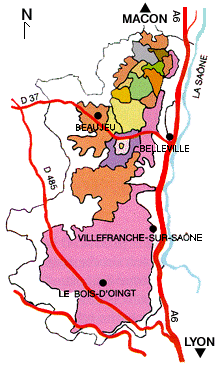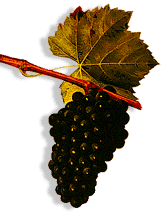As Caesar's army crossed the Alps and into Gaul in the 1st century B.C., they built temples, aqueducts, amphitheatres and roads. Along those roads, Rome's army planted the vine. There is still evidence today in Brouilly and Morgon of those Roman vineyards. After Rome left, the area was invaded by the Barbarians and then the Arabs who also tended the vines and enjoyed the fruits thereof. Founded in the 10th century by the powerful nobility that created the principality, the town of Beaujeu in the western hills of Beaujolais, gives the region its name. It was ruled by the Dukes of Beaujeu until it was ceded to the Bourbonnais in 1400.
The region really began to develop an identity distinct from its northern neighbor Burgundy, after Philippe the Bold made his famous decree in July 1395, outlawing the Gamay grape and forbidding its cultivation in the great duchy of Burgundy proper. So Burgundy went with Pinot Noir and Beaujolais went with Gamay. Although the edict was not at all popular with the growers of his day, it proved to be a good thing for each of the two regions. Here in Beaujolais, the Gamay grape is in its element.
Pour with Confidence! Since 1990 The California Wine Club has featured the best of California’s small, artisan wineries.
Each month features a different winery and includes:
- Two bottles of limited production, award-winning wine
- Entertaining and informative 12 page club magazine, Uncorked
- A 100% satisfaction guarantee
- An opportunity to reorder your favorites at up to 50% off normal retail prices
$35.95 per month, plus s/h. No membership fees, no commitment.
Visit www.cawineclub.com to learn more.
Pronunciation Guide
Beaujolais [BOE-zjoh-lay]
Brouilly [BREW-yee]
Chiroubles [shee-ROOB-luh]
Chénas [shay-NAH]
Côte de Brouilly [coat duh BREW-yee]
Cru or Crus [crew]
Fleurie [FLUR-ee]
Juliénas [ZJOO-lee-ay-nah]
Morgon [more-GOH]
Moulin à Vent [MOO-lan ah vahn]
Négociant [nah-GO-SEE-ahn]
Régnié [reh-N'YAY]
Saint Amour [sant ah-moor]
The Region
Located South of Burgundy proper, between Mâcon and Lyon, Beaujolais is a prosperous region. Cultivating almost 55,000 acres, more than the other three departments of Burgundy combined, it produces an average of 13 million cases annually. Best of all, once a year, when the world falls in love with Beaujolais Nouveau, nearly half of this crop is pressed, fermented, racked, fined, filtered and sold within weeks. The rapid cash flow generated is the envy of winemakers everywhere.

From the 16th century onwards, the grape gradually became the dominant crop of the region. This was aided largely by improvements in transportation. As transportation improved the market expanded. For centuries, Lyon was the region's principle market. A crucial development for the economy was the opening of the Braire Canal to link the Loire and the Seine Rivers. Now Beaujolais was only two or three days journey by wagon to a water route that would take the wine all the way to Paris.
As the market for wines grew, new vineyards were planted away from the small towns and villages, and on better the soils and exposures of the hill slopes. Thus the "soil-zones" of Beaujolais were beginning to take shape.
Developing at the same time was a system of viticuture that exists to this day. Unlike Bordeaux, there are no large properties in Beaujolais. The system, called "vigneronnage," consists of hundreds of small to medium sized properties on which the grapes are grown. Most of these grapes are purchased by Négociants who make and market the wines.
Beaujolais is comprised of 12 appellations and is divided into Haut- and Bas-Beaujolais. This division is based on distinctions in the soil of each area. The valley of the River Nizerand, just north of the regional capital of Villefranche, is the dividing point. South of the river is the flat plains of Bas-Beaujolais. The soil here is rich and mostly limestone/clay with occasional sandy patches. The soil produces more quantity than quality.

Beaujolais has the warm summers and cool winters indicative of a temperate climate. Snow is common in the winter as a result of its proximity to the Massif Central Mountains to the west. The hills of Beaujolais do provide some protection from the cold and rain generated in these mountains, but in late summer, hail storms are an all too frequent threat to the growers.
The Wine
Beaujolais is the young, refreshing, and fruity wine that has been so popular in the French cafes. Traditionally served from a 1.2 gallon jug, it is a carafe wine or as the French would say in Lyon, a "bouchons" wine. The fruity, exuberant, intensely aromatic wines produced here, owe a lot not only to the Gamay grape, but to the style of vinification used. In Beaujolais a variation of the maceration carbonique method or more simply, what has become to be known as the Beaujolais Method, is used. The strength of this method is that it extracts the maximum color and aroma from the grape without the astringency associated with red wine. The inherent fresh, fruity, and juicy characteristics of the Gamay grape make this a good marriage.

The 12 appelations of the region are divided into 3 categories or levels of quality - the basic Beaujolais, Beaujolais-Villages and the Crus of Beaujolais. About half of all Beaujolais produced, approximately 7 million cases a year, is sold as Beaujolais. This is wine from grapes grown in the southernmost region called Bas-Beaujolais. The minimum alcoholic degree is 9. These flowery and fruity wines must be drunk young, as they are not intended for keeping.
With a minimum of 10 degrees of alcohol, Beaujolais-Villages is the next level. Wines bearing the Beaujolais-Villages label are restricted to using grapes coming from at least 2 of the 39 communes in Haut-Beaujolais and account for about a quarter of the total annual production of this region. Due to the better growing conditions, these are better wines with more complexity and depth. They can be kept from one to three years.
Within the northernmost part of this region are the 10 crus - Saint-Amour, Juliènas, Chenas, Moulin à-Vent, Fleurie, Chiroubles, Morgon, Régnié, Brouilly, and Côte de Brouilly - that have been singled out and named due to their distinctive characteristics. That being said, these distinctive characteristics are not always that easy to detect and can be quite subjective. Brouilly is said to be grapey, while Fleurie is said to have the aroma of violets and Saint-Amour of peach. Categorically, Brouilly, Côte de Brouilly, Fleurie, Saint-Amour, and Chenas, share a common elegance and fragrant delicacy, whereas Juliènas, Morgon, and Moulin-à-Vent, are fuller, have a deeper flavor and have more lasting power.

Régnié is the most recent of the Beaujolias wines to be assigned the prestigious cru status, joining the others in 1988. Perhaps the most famous of the crus is Moulin-à-Vent. Its name comes from an ancient windmill built on the hills surrounding the town of Romanéche-Thorins. Its great aging potential and exceptional quality is attributed to the granite subsoil of the area.
Chénas is next door to Moulin-a-Vent and is the rarest of the ten cru. With more aroma than Juliénas, this is a heady wine for laying down.
Brouilly and Côte de Brouilly are separate crus as Côte de Brouilly is grown on the volcanic hillsides of the 1585 foot Mont Brouilly and the grapes of Brouilly are grown on the plains around about it. Brouilly is the largest and highest yielding of the Beaujolais crus with 3000 acres under vine.
The wines of Beaujolais, whether basic or cru, provide immediate enjoyment at reasonable prices. Their easy compatabilty with food and under $10 pricing, make them a value not to be missed.






